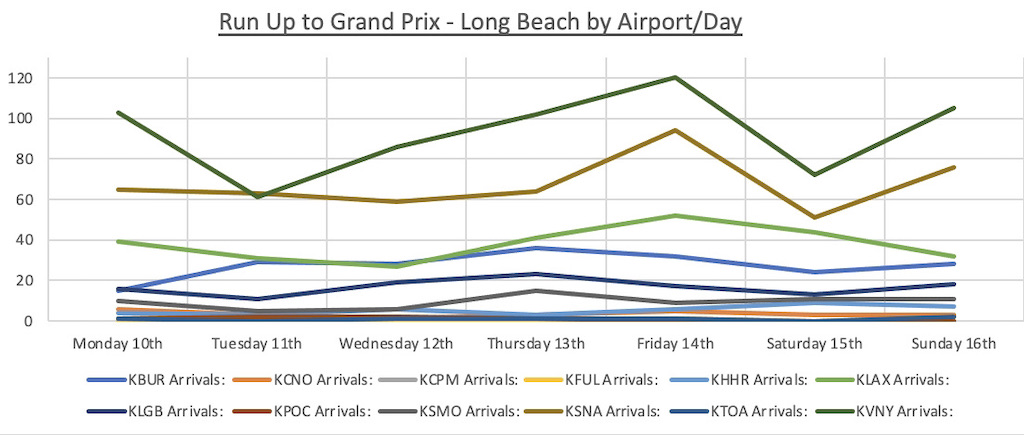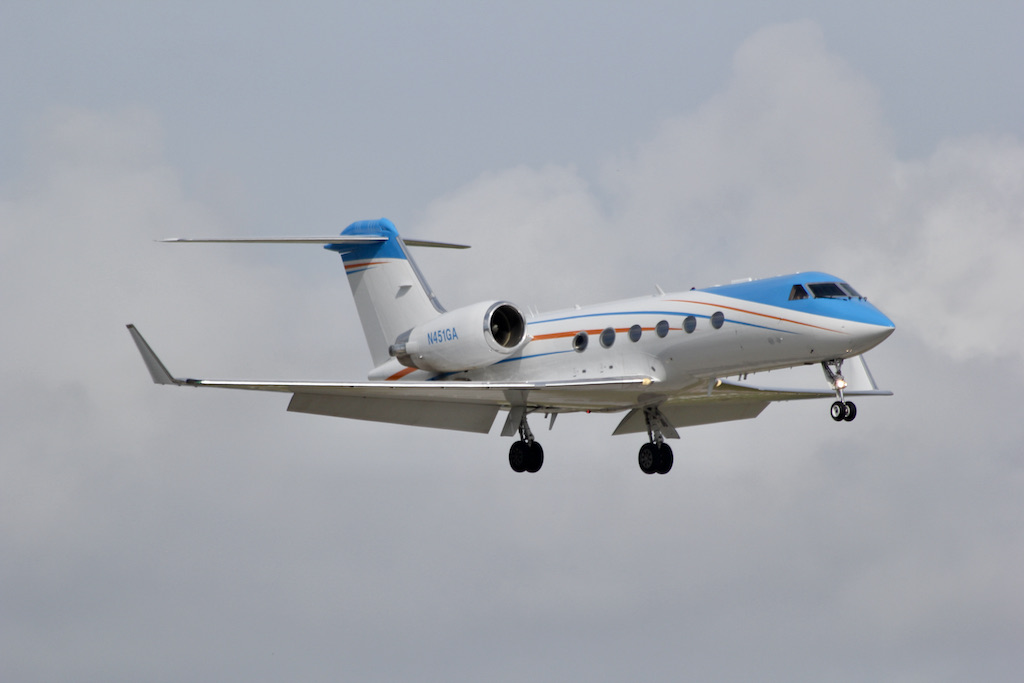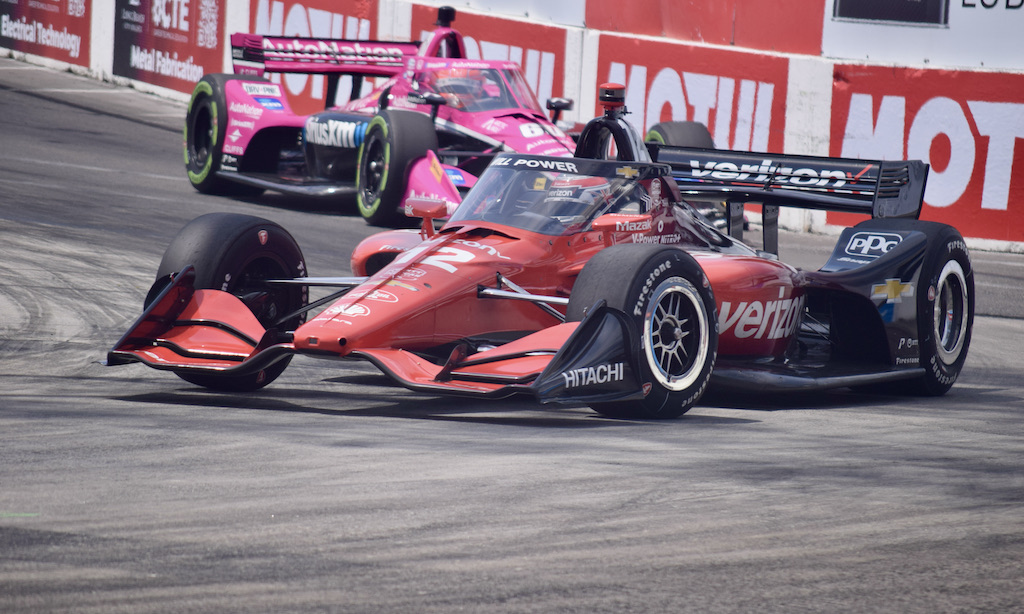
Andretti Autosport's Devlin DeFrancesco in No. 29 car rounds Turn 11 at Grand Prix.
LONG BEACH, California--Aerodynamic and exhilarating, race cars and business jets are mutually attractive.
“There’s a big aviation industry in NASCAR itself that flies all of these race teams,” the third-generation NASCAR champion Dale Earnhardt Jr. told NBAA President and CEO Ed Bolen during a keynote conversation at the 2022 NBAA-BACE conference. “Every team probably sends about 40 people to the racetrack and there’s 40 teams on the Cup level, another 40 teams on the Xfinity Series level, so hundreds of people going to the racetrack, plus all the officials and NASCAR industry folks. … I couldn’t imagine being able to function in our industry without [aviation].”
Earnhardt said he was reminded of the similarities between aviation and motorsports by an aircraft mechanic who worked for him. “The preparation and the meticulous effort that he puts into maintaining our plane reminds me a lot of a racing mechanic—the details, the perfection, the quality, the craftmanship, all of those things are absolutely comparable,” he said. “The preparation of the plane, the maintenance on the plane—that’s very similar to our race cars. They have to be perfect, they have to perform perfectly.”
A two-time Daytona 500 winner and NASCAR Hall of Fame inductee, Earnhardt remained enthusiastic about aviation even after he, his wife and daughter and two pilots narrowly escaped from their Cessna Citation Latitude after it crash-landed and caught fire at Elizabethton Municipal Airport in Tennessee in August 2019.
“In a week I was back on a plane, or even sooner,” Earnhardt told the Bussin’ With The Boys program in April 2020. “Now I’m a little bit more nervous about landings but I got right back to it.” The crash, however, was “life-shattering” for his wife and discouraged him from taking his daughter on flights. “That’s the hard part for me, otherwise I’m comfortable,” he said. “I’m back in the air.”
Bizjets And Indycars
The mutual attraction was evident during the recent Acura Grand Prix of Long Beach, a three-day “spectacle of speed and sound” that drew a reported 192,000 people to the streets of downtown Long Beach, California, its highest turnout since 2008. The 48th running of the Grand Prix featured six classes of vehicles doing battle in separate races; the main event was the third round of the 2023 NTT Indycar Series.
Kyle Kirkwood bested the field of 27 drivers to win the 85-lap (167-mi.) Grand Prix in an AutoNation Honda, scoring his first NTT Indycar Series victory. Kirkwood took the lead for good on Lap 56 of the 11-turn course encircling the Long Beach Convention Center. His average speed was 97.171 mph.
Similar in appearance to European Formula 1 racers, Indycars are open-wheeled, open-cockpit vehicles that compete on ovals, road courses and street circuits; they are lighter and faster (capable of reaching speeds of 225 mph) but less robust than NASCAR stock cars that race on road courses and tracks where bumping is allowed.
In May 2019, NetJets and Hulman Motorsports (later acquired by Penske Corp.) announced a multiyear agreement under which NetJets became the official private aviation partner of the 17-race NTT Indycar Series and the Indianapolis Motor Speedway.
Air Traffic Increase

Aviation services and analytics specialist Argus International provided metrics exclusively to BCA for business aircraft arrivals at Long Beach-area airports during the week before (April 3-9) and the week of (April 10-16) the Acura Grand Prix of Long Beach. The data show that total business aircraft arrivals at 12 airports in the Long Beach vicinity increased by 330 aircraft to 1,840 the week of the Grand Prix from 1,510 the prior week—a 22% bump.
There was an increase in arrivals specifically in the latter part of the Grand Prix week on Thursday, Friday and again on Sunday, with larger increases on those days (910 total) compared to the prior week’s Thursday, Friday and Sunday (714 total).
Top Arrival Airports

The top airports for arrivals during the latter part of the Grand Prix week were, in order: Van Nuys Airport (KVNY), John Wayne Airport (KSNA), Los Angeles International Airport (KLAX), Hollywood Burbank Airport (KBUR) and Long Beach Airport (KLGB).
Top Arriving Aircraft

The top three arriving aircraft types for all airports combined during the week of the Grand Prix were the Gulfstream G-IV (143) followed by the Embraer Phenom 300 (128) and the Bombardier Challenger 350 (97).
Total fuel burn across all airports increased to 923,020 gal. the week of the Grand Prix compared to 887,393 gal. the prior week.
The Race For Sustainability

Motorsports and business aviation complement each other in another way; they share the imperative of becoming more sustainable. Starting this year, the NTT Indycar Series introduced Shell 100% Renewable Race Fuel, making it the first U.S. motorsports series to use 100% renewable fuel.
The new product consists of a blend of second-generation ethanol derived from sugarcane waste, sourced from Shell’s Brazilian joint venture Raizen, and other biofuels. Indycar team transporter trucks that support the series run on 100% renewable diesel fuel.
In collaboration with engine suppliers Honda and Chevrolet, the Indycar Series is testing a 2.2-liter twin-turbocharged V-6 powerplant with hybrid technology. Plans to introduce a new hybrid 2.4-liter turbo V6 engine with increased horsepower to 900 hp in 2024 have been paused “to allow the innovative hybrid technology to be paired with the proven” V-6 engines.
Data for Business & Commercial Aviation was provided by Argus Analytics, an SGS Company. Argus Analytics offers a wide selection of highly customized flight data reporting based on business needs, including for sporting events.


